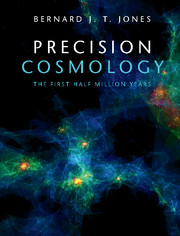Book contents
- Frontmatter
- Dedication
- Contents
- Preface
- Notation and Conventions
- Part I 100 Years of Cosmology
- Part II Newtonian Cosmology
- Part III Relativistic Cosmology
- 10 Minkowski Space
- 11 The Energy Momentum Tensor
- 12 General Relativity
- 13 Space-Time Geometry and Calculus
- 14 The Einstein Field Equations
- 15 Solutions of the Einstein Equations
- 16 The Robertson–Walker Solution
- 17 Congruences, Curvature and Raychaudhuri
- 18 Observing and Measuring the Universe
- Part IV The Physics of Matter and Radiation
- Part V Precision Tools for Precision Cosmology
- Appendix A SI, CGS and Planck Units
- Appendix B Magnitudes and Distances
- Appendix C Representing Vectors and Tensors
- Appendix D The Electromagnetic Field
- Appendix E Statistical Distributions
- Appendix F Functions on a Sphere
- Appendix G Acknowledgements
- References
- Index
14 - The Einstein Field Equations
from Part III - Relativistic Cosmology
Published online by Cambridge University Press: 04 May 2017
- Frontmatter
- Dedication
- Contents
- Preface
- Notation and Conventions
- Part I 100 Years of Cosmology
- Part II Newtonian Cosmology
- Part III Relativistic Cosmology
- 10 Minkowski Space
- 11 The Energy Momentum Tensor
- 12 General Relativity
- 13 Space-Time Geometry and Calculus
- 14 The Einstein Field Equations
- 15 Solutions of the Einstein Equations
- 16 The Robertson–Walker Solution
- 17 Congruences, Curvature and Raychaudhuri
- 18 Observing and Measuring the Universe
- Part IV The Physics of Matter and Radiation
- Part V Precision Tools for Precision Cosmology
- Appendix A SI, CGS and Planck Units
- Appendix B Magnitudes and Distances
- Appendix C Representing Vectors and Tensors
- Appendix D The Electromagnetic Field
- Appendix E Statistical Distributions
- Appendix F Functions on a Sphere
- Appendix G Acknowledgements
- References
- Index
Summary
The Einstein field equations relate the geometry of space-time to the source of the curvature: the material and energy that pervade the Universe. This is the essence of the theory of general relativity, ‘GR’. In their full generality the equations cannot be solved analytically, they are nonlinear partial differential equations which can only be solved in situations of high symmetry. In the case of weak gravitational fields we recover Newton's theory, as we should expect. Importantly, the theory also provides us with the local inertial frames of the special theory of relativity. In this way, the well-established classical physics is ‘safe’, we do not have to rewrite our textbooks.
Locally, we live in the arena of weak quasi-Newtonian gravitational fields. The geometry is slightly curved, otherwise there would be no gravitation at all, and so the metric of the space-time is almost the Minkowski metric. Knowing this we can easily go the one or more steps beyond Newton and look for tests of these post-Newtonian deviations. The classical tests such as gravitational lensing and planetary orbits provide strong evidence for GR at this level. In recent decades we have seen the rise of GPS devices that require the use of GR in order to return correct positions.
Non-Newtonian predictions, such as strong gravitational fields, i.e. black holes, and gravitational waves are now being tested. We have abundant evidence for black holes from the study of the nuclei of galaxies. The existence of gravitational waves was inferred from the decay of binary stellar orbits and now they have been detected directly using gravitational wave antennas.
General relativity, or some modification of the theory, is the framework for gravitational physics. In this chapter we look at the experimental support for Einstein's theory and consider possible alternative theories. We also address the question as to how we should carry over our understanding of the laws of physics to the curved space-times of general relativity.
The Einstein Equations
Einstein's leap of imagination, seeing the gravitational field as being an aspect of the curvature of space-time, is surely one of the most profound scientific insights ever. The geometric insight was not the only one: Einstein recognised the energy–momentum tensor as being the source of the space-time curvature. But the energy–momentum tensor involves the metric, and in this way geometry and matter are intertwined and inseparable.
- Type
- Chapter
- Information
- Precision CosmologyThe First Half Million Years, pp. 340 - 357Publisher: Cambridge University PressPrint publication year: 2017



